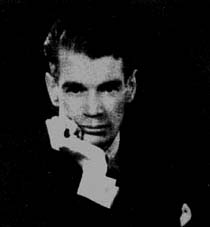Many ex-Holzminden POWs went on to distinguish themselves after the war. Others were not so fortunate. Here are just a few:
|

|
JAMES WHALE - Hollywood Film Director
Englishman James developed a love of drama and theatre when he became involved in the Gaiety Theatre, an amateur theatre group formed by Holzminden prisoners to stave off boredom. He went on to distinguish himself as film and theatre director in Hollywood, directing over 23 films such as Frankenstein (1931), The Bride of Frankenstein (1935), the musical Showboat (1936) and The Man In The Iron Mask (1939).
|
 |
HECTOR FRASER DOUGALL - Media Pioneer
Trench warfare prompted Canadian Expeditionary Force Lieutenant, Hector, to seek a commission in the Royal Flying Corps. Shot down over France, he was incarcerated at Holzminden in May 1918 but not before he made many colourful escape attempts. When the Holzminden camp was liberated in December 1918, Hector climbed to the top of the camp flagpole and captured the Prussian flag which bore the State emblem of an eagle. When he returned to Canada, he remained close to his aviation passion -- flying in air shows, barnstorming and forming the Fort William Aero Club. He also co-formed the Dougall Motor Car Co., and later two radio stations and a CBC-affiliated television station.
|

|
SIDNEY STEWART HUME - Pyschiatric Patient
Not all POW stories had a happy ending. Argentinian-born Sidney, a spotter/observer in the Royal Flying Corps, was shot down over France in May 1917. He was incarcerated in a number of POW camps, where he was reportedly treated badly by his German captors, who he accused repeatedly of hypnotising him. The psychological anguish of his experiences -- real or imagined -- triggered a backward slide in to mental illness which was to become Sidney's constant and tragic companion. Back in England after the war, he was diagnosed with delusionary insanity and shot dead an orderly whom he mistakenly believed to be a German spy. Sidney was to be tried for murder, but instead was incarcerated in a psychiatric facility for the rest of his century-long life.
|
 |
WILLIAM LEEFE ROBINSON - Flying Ace
William was a 21-year-old India-born English fighter pilot when he distinguished himself by being the first Royal Flying Corps aviator to shoot down a raiding German airship over London one night in September 1916, killing German Commander Schramm and his 15-man crew. His victory was short-lived, however, as in April 1917, Robinson was engaged in an aerial dogfight with the Red Baron and his cohorts over France when he was shot down and sent to Holzminden. Unfortunately for Robinson, he had fallen into the hands of a personal friend of the dead airship commander. Hauptmann Niemeyer, Kommandant of Holzminden, made it his business to make Robinson suffer, mistreating the young pilot appallingly at every opportunity, contributing to Robinson's early death at 24.
|



